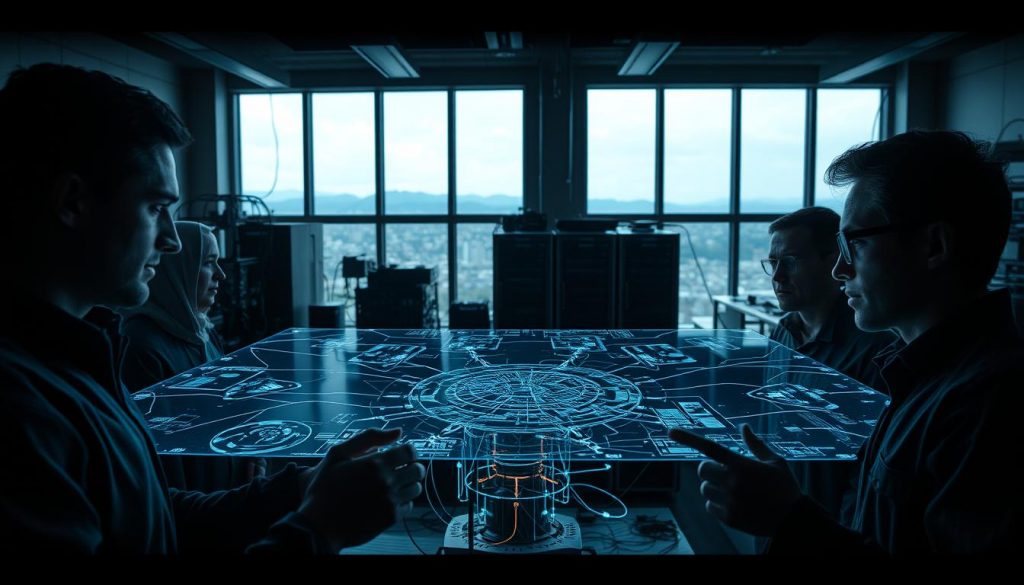Google Beam Video Conferencing: What You Need To Know!. In today’s world, remote work, digital teamwork, and virtual meetings are common. Google Beam is an exciting development in this area. But what is it? How does it function? More importantly, how might it change how we communicate in 2025 and the years to come?
In this article, we’ll break down everything you need to know about Google Beam video conferencing—from how it works to why it matters for businesses, educators, healthcare providers, and more.
Key Takeaways
- Google Beam is a pioneering 3D video calling technology.
- The technology is set to be commercialised in 2026 through a partnership with HP.
- Promises to revolutionise the way we communicate by enabling more immersive interactions.
- Holographic calling technology has the power to change the future of video communication.
- The launch of Google Beam is expected to bring big changes to how we talk to each other from afar.
What Is Google Beam?
Google Beam (Formerly project Starline) is an advanced video conferencing technology that allows people to communicate as if they’re sitting across from each other—in life-sized 3D. Instead of a flat video feed, Beam uses light field technology, depth sensors, computer vision, and AI to create a three-dimensional, hologram-like experience.
Google Beam is a real initiative that is being tested in businesses.
How Does Google Beam Work?
It uses 3D models and fast video connections. Here’s a simple explanation of the technology:
- Depth cameras take pictures of you from different angles.
- Light Field Displays present a realistic, volumetric 3D image.
- Real-Time Compression Algorithms ensure smooth streaming.
- Eye Tracking & Spatial Audio enhance realism and emotional connection.
This technology eliminates the flat, disjointed feel of standard video calls and makes it feel like you’re truly “there” with the other person.
Why Is Google Beam Important?
Hybrid work models, virtual healthcare consultations, and global team online meetings are more prevalent than ever, and the need for clear communication has grown, which is where Google Beam comes in.
Unlike Zoom or Microsoft Teams, which use flat 2D screens, it offers a more lifelike experience. This is perfect for:
- Business leaders having important meetings
- Doctors providing virtual care with a personal touch
- Educators teaching students who are learning from home
- Designers collaborating on 3D prototypes
Key Features of Google Beam
1. Real-Time 3D Communication
Participants appear in front of you in true-to-life scale, depth, and detail, making conversations more natural and engaging.
2. Eye Contact and Non-Verbal Cues
Starline is different from standard video calls because it can replicate real body language and eye contact, which helps people communicate better.
3. AI-Enhanced Audio and Visuals
- Google uses Artificial Intelligence to enhance audio and visuals, which automatically adjusts lighting, sound, and background, making conversations clearer and more focused.
4. Plug-and-Play for Enterprises
- The new booths are small and easy to set up in offices, unlike older models that were bigger and more complex.
How Businesses Will Be Using Beam
Many businesses will adopt Beam to improve their communication. Here are some examples:
Corporate Collaboration
- Executives can conduct board meetings, mergers, and negotiations where nuance and presence matter.
Telemedicine
- Hospitals, clinics, and doctors can visually assess patients remotely with a more human touch.
Remote Hiring and Training
- HR teams can conduct immersive interviews and onboarding sessions that improve trust and engagement.
Education and Research
- Universities and research labs can collaborate across countries with more realistic classroom and lab simulations.

Benefits of Using Google Beam
Many businesses are investing in Google Beam for several reasons:
- Improved Connection: This technology makes people feel more present, which increases empathy, trust, and teamwork.
- Cost Savings: It helps reduce travel costs, saving both time and money.
- Better Outcomes: In areas like healthcare and education, the added realism helps people understand each other better and make better decisions.
- Brand Leadership: Using advanced tools shows that a company is innovative and dedicated to better communication.
Challenges and Limitations
Despite its advantages, it has some challenges:
- First commercial version of Google Beam, is priced at $24,999
- Cost and Accessibility: The technology is still pricey and mostly available to large businesses.
- Space Requirements: It needs a dedicated area and special equipment.
- Privacy Concerns: Like all AI tools, it raises important questions about data privacy and security.
As more businesses start using it and costs decrease, these challenges are expected to lessen in the coming years.
What’s Next for Beam?
Google plans to make the system available to more businesses and seeks partnerships. They are also working on:
- Smaller and more affordable units
- Software upgrades using AR/VR headsets
- Better integration with current conferencing tools
As technology improves, Google Beam is likely to become more accessible and common by 2026 or 2027.
Should You Invest in Google Beam?
It depends on your business size. If you are a large company, healthcare provider, or a tech-savvy business, looking into Project Starline can give you an advantage. If you run a smaller business, it may be better to wait until prices go down and more people start using it.
Conclusion: The Future of Video Conferencing Is Here
Google Beam is more than just a video conferencing tool—it offers a new way for people to connect. It uses AI, 3D imaging, and display technology to overcome many limitations of traditional video calls.
As we move through 2025, businesses that focus on genuine and meaningful communication will benefit the most from this advanced platform.
Stay ahead of the curve—watch this space as Google Beam continues to evolve and shape the future of digital communication.


